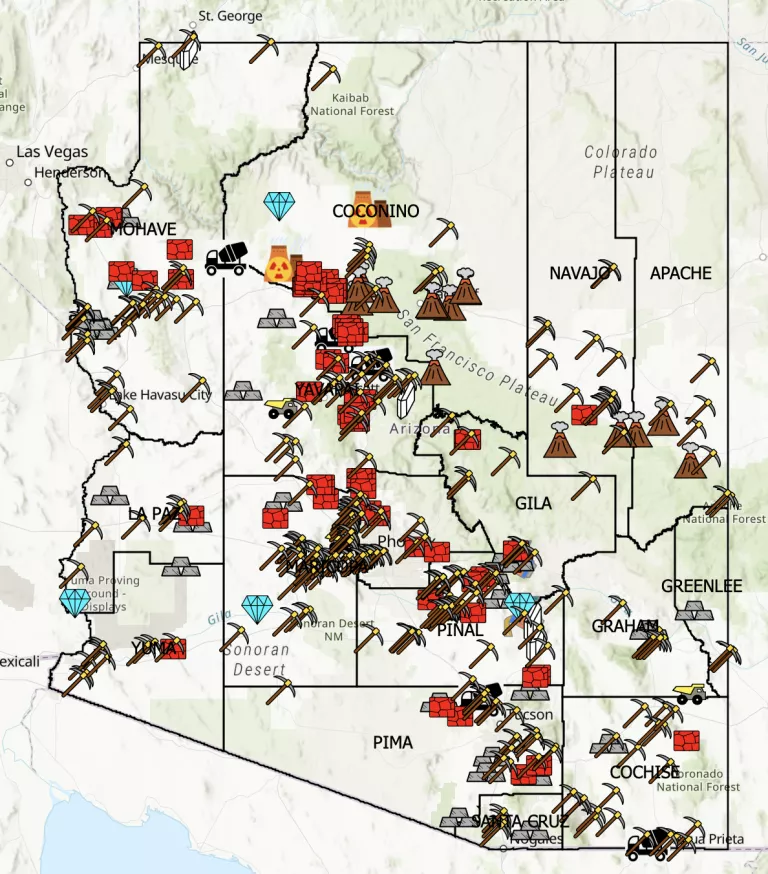All Our Blogs / Blog for Articles / "Canyon Echo Summer 2024" ...
Mining Arizona - Destroying Lands, Cultural Sites, Waters, and Wildlife Habitat
~ by Gary Beverly
In Arizona, you can’t go far without passing a mine.

Plate tectonics has blessed (or cursed?) Arizona with abundant mineral resources including copper, gold, lithium, uranium, zinc, lead, coal, and more. Our economic system depends on these raw materials, extracted from the earth at the expense of the environment and indigenous people. This reckless exploitation is permitted by obsolete federal mining law.
Gold:
- Historic abandoned hard rock gold mines are scattered throughout our mountain ranges,
- some draining acidic water laced with heavy metals such as arsenic and cadmium.
- Riparian waterways have been scarred by placer mining.
- Gold Paradise Peak, a new open pit gold mine -- is proposed near a residential neighborhood southwest of Prescott.
Coal:
- Now closed, the Peabody coal mine (near Kayenta) dewatered springs needed by Hopi and Navajo families.
- Shady lawyers conspired with the Bureau of Indian Affairs -- to defraud the tribes of fair royalties.
- This coal was used to pump Central Arizona Project (CAP) water -- to central and southern Arizona.
Lithium:
- Mines proposed for the Big Sandy (near Wickiup) are offensive to the Hualapai people -- as they threaten their sacred Ha’Kamwe’ springs.
Uranium:
- There are hundreds of abandoned uranium mines on the Navajo Nation
- that exposed thousands of miners to cancer-causing radiation.
- Those mines have yet to be cleaned up.
- The White Mesa mill in southern Utah threatens to pollute the Colorado River and groundwater.
- The newly active Pinyon Plain mine (near the south rim of Grand Canyon) is likely to contaminate groundwater -- feeding the waters of the Havasupai Tribe and Grand Canyon.
Copper:
- Giant open-pit mines litter the state.
- Ajo, Bisbee, and Jerome are now inactive.
- Bagdad, Morenci, Ray, Safford, and Pinto Valley -- are currently active.
- The Sierra Club is vigorously opposing two huge and controversial proposed copper mines:
- Rosemont Copper, now Copper World (southeast of Tucson)
- and the Resolution Copper Mine (east of Superior)
- which would desecrate Apache spiritual practice and consume vast amounts of groundwater.
Many of the abandoned mines are environmental hazards–the miners left a mess for taxpayers to clean up. One example of many is the Iron King/Humboldt Smelter Superfund site (near Dewey/Humboldt) -- which contaminated land and groundwater with arsenic.
Some mines are on tribal lands -- but most are on public land managed by the US Forest Service or the Bureau of Land Management -- and were facilitated by the 1872 Federal Mining Act...
This ancient legislation is the root of the issue. It requires land managers to permit mining on public land! It strongly limits requirements for environmental protection.
- It does not require royalty payments, thus permitting foreign-owned corporations to extract mineral wealth that belongs to U.S. citizens without royalty, and to export that wealth overseas.
- Fundamentally, it authorizes theft of public resources by foreign corporations without environmental protection.
- The proposed Copper World and Resolution copper mines are owned by Canadian, British, and Australian corporations.
- The proposed Gold Peak mine is owned by a Chinese company.
- The only effective law regulating mines is the federal Clean Water Act, administered by the Environmental Protection Agency and the Arizona Department of Environmental Quality, which only controls the quality of water leaving the mine site.
- Arizona state law regulates mining only lightly and water use is unregulated.
The Grand Canyon Chapter fights to limit the environmental damage caused by mines. The Sierra Club has struggled for decades to revise the 1872 Mining Act, but the mining industry is rich and powerful. Still, there are opportunities to place limits on groundwater pumping from mines, and, if the right conditions arise, ensure stronger Clean Water Act protections and reclamation requirements.
We are calling on the Biden Administration and Governor Hobbs to use the tools they have to protect our lands, waters, wildlife, and our health from harmful impacts of mining. President Biden protected nearly a million acres of national forest and Bureau of Land Management lands from future mining when he proclaimed the Baaj Nwaavjo I’tah Kukveni–Ancestral Footprints of the Grand Canyon National Monument. That was an important action–and we need more of that.
~ By Gary Beverly